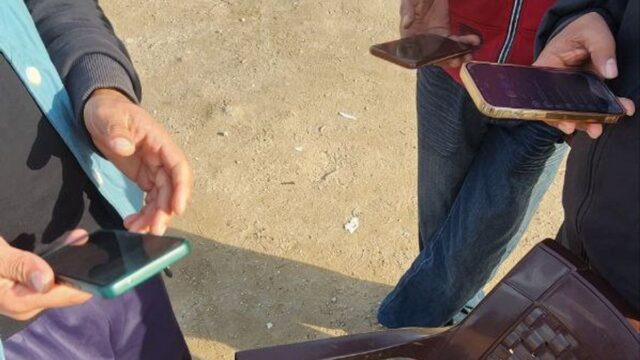Israel’s war on Gaza has made communications in the Strip difficult, but the population manages to overcome it and connect to the internet with innovative solutions and the support of NGOs.
Connecting to internet service has become a challenge for residents of war-torn Gaza, as civilian telecommunications have become another target since the war between Israel y Hamas.
Internet providers in the area have suffered serious outages since the beginning of October 2023, according to the digital rights NGO. AccessNow in a report from the beginning of November titled Disconnected Palestine: How Israel disrupts the internet in Gaza.
In recent months, network monitoring services such as Cloudflare Radar y NetBlocks They have reported several internet outages in Gaza.
The main telecommunications company on the strip, Paltel, had more than 500 operational mobile phone towers in the enclave, but 80% of them have been destroyed by Israel, As Paltel’s head of operations explained in March, Hamzah Naseefin American public radio station NPR.
These circumstances have led Gazans and humanitarian organizations to seek emergency solutions to get connected.
Plant “network trees” to access the Internet
An example is the GazaWeb project of the Italian charity Association of Cooperation and Solidarity ACS).
With the help of volunteers in Gaza, this organization has helped keep the population connected through Israeli and Egyptian cell towerss.
Using smartphones compatible with embedded SIM (eSIM) technology, the NGO has been able to deploy several internet access points in the border areas of the Gaza Strip.
To the volunteers of the area, called “gardineros”, are paid to obtain compatible phones and are sent a eSIM code.
Once set up, they hang the devices high above areas where they receive signals from cell towers in neighboring countries and serve as a Wi-Fi hotspot for people below the phone. They are called “network trees“.
Since January, the GazaWeb project has managed to install 15 of these “trees” in cities such as Al Mawasi, Deir al-Balah, Gaza City, Jabalia y Rafah.
The coordinator of the GazaWeb project, Manolo Luppichinihighlighted the importance of these access points not only for obtaining information from outside Gaza, but also for daily life inside: “Not having internet, not having a telephone signal, means that many people are stranded and have no connection to with their family, with their relatives, with their friends. They don’t know when things happen, they have no information,” Luppichini explained to Euronews Next.
However, the availability of this system is constantly changing: the connectivity of each point depends on a single mobile phone, stuffed inside a cube and connected to a power source so that the battery lasts at least two or three hours.
“The access point consumes much more power, otherwise (without the power bank) it only lasts a few minutes in those conditions,” Luppichini explained.
Danger of death for trying to connect to the internet in Gaza
Sometimes Israeli bombing prevents the batteries from being safely recharged, which complicates the maintenance of these “net trees,” according to Luppichini.
Both the installation of access points and their use have also become a risk during the war.
Luppichini told Euronews Next that on June 26, eight people were killed in an Israeli attack while using one of these access points in Jabalia, north of Gaza.
The number of victims coincides with the information published the information published by the Palestinian News and Information Agency (WAFA) about an Israeli bombing in the same area, citing local sources.
“This is the third time. People who gather to connect are exposed to the threat of bombing, because they see this gathering of people and bomb it. Obviously, you have to gather because there are few places that can receive the signals, it depends on part of the street you are on.
At least 20 people have died trying to connect to the internetaccording to the coordinator of GazaWeb. “The number of victims is always difficult to verify. Many other injured people could be dead,” she explained.
During the war between Israel and Hamas, Gazans have been sharing videos about their daily lives on social media. This is not new, but Luppichini believes there is something distinctive about this conflict.
“There is a new way of telling stories. It has happened before in different ways, but it is the first time that people subjected to such a siege, such a violent situation, tell their story. They are broadcasting a genocide live“, he assures.
South Africa has filed a lawsuit with the International Court of Justice (ICJ) alleging that Israel is committing genocide in Palestine, something Israel denies.
The challenge of finding a reliable system
ACS began looking for solutions to Gaza’s internet problems in mid-October, at the beginning of the current conflict.
“Getting satellite phones into Gaza across the border was impossible,” Luppichini explains.
They also attempted to install a cell phone tower to provide a mobile connection from Egypt at the Rafah border, but they could not cooperate with the Egyptian authorities.
Signals from Egyptian and Israeli cell towers can penetrate some two or three kilometers inside Gaza.
The GazaWeb project coordinator said they are currently encouraging their “gardeners” to try installing these internet access “trees” in populated areas using the raised bucket method.
“Women especially have a hard time walking down the street and getting to the points where they can get internet. With this cube system they can get the signal inside the houses,” said Luppichini.







